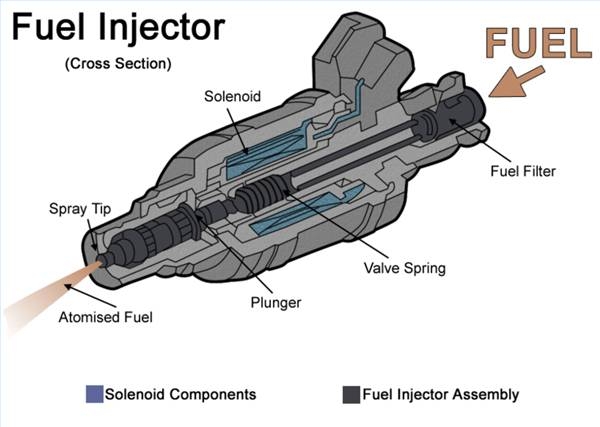
Fuel injectors have been used in different gasoline injection system designs and configurations with such success that they are now a standard in vehicle fuel systems. Injectors have made it possible to improve driveability, engine efficiency and control as fuel injection systems have replaced the traditional carburetor entirely. And even though vehicle manufactures keep developing and improving fuel system designs, the useful fuel injector remains in place.
When you start the engine, the fuel pump in the gas tank feeds fuel under pressure to the throttle body injector or multiport fuel injectors. A fuel pressure regulator keeps this pressure at a constant level. At the same time, the engine control module or computer receives engine temperature, throttle position, air stream density and temperature and crankshaft speed data from sensors. The computer then uses this information to operate the fuel injectors and control the amount of time the injector remains open for fuel delivery to the engine.
The fuel injector is an electrical solenoid or coil operated by the engine computer. When energized, the injector screens fuel fed through the fuel line to keep dirt and waste from entering the injector. Electric current then operates a coil to open a needle valve at the tip of the injector, allowing the injector nozzle to spray fuel into the intake manifold. A spring closes the needle valve again when energy is cut to the injector.
Fuel injectors in multiport fuel systems help control fuel delivery to the engine with more precision than carburetor or throttle body injector systems, helping the engine computer lower harmful emissions and increase engine power output. Injectors provide better fuel distribution, economy and idle operation.
Electronic fuel injectors are used in two common types of gasoline injection systems: the throttle body injection system uses one or two injector nozzles in the throttle body, sitting on top of the engine, to feed fuel into the intake manifold; the multiport injection system may use one or two injectors for each cylinder to feed fuel directly through intake ports.
A failed fuel injector is easy to replace. However, always make sure to relieve fuel pressure from the fuel system before attempting to remove an injector. Unplugging a fuel line under pressure may squirt gasoline with enough force to cause eye injury or fire. Consult your vehicle service manual for the correct procedure to service the fuel injectors or fuel system in your car.